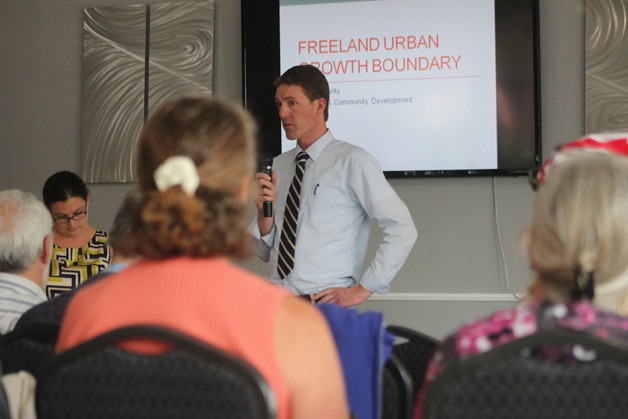A small and vocal crowd of Freeland residents let Island County planners know Thursday they wanted the smallest possible urban growth area boundary.
About 40 people attended a county planning department-hosted meeting concerning the urban growth area, a zone that allows urban-type development, with features such as sewers, sidewalks and higher density housing. Outside of an urban growth area, development becomes less dense and cannot have urban features.
It was the second meeting in two months regarding Freeland’s future. The past meeting in July was about regulations and what Freeland should look like.
August’s meeting was about where it should grow, and in what ways.
Based on modest population and job growth projections, the county established four baseline options for the boundary. People’s interest quickly zeroed in on the smallest and largest options, with voiced opinions only in favor of the smallest possible urban growth area (UGA) for the unincorporated area of Freeland.
“If people don’t believe we need that amount of land for those projections, that would be the logical conclusion,” said Brad Johnson, Island County senior planner. 
Freeland’s non-municipal urban growth area (NMUGA) is projected to see about 1,770 people — an addition of 140 with another hundred jobs — by 2036. Compared to past projections that forecast a total of 4,000 residents, identifying a smaller UGA made more sense for the county and several residents who spoke at Thursday’s meeting.
One man asked if the county could establish an even smaller UGA boundary option.
“I do not believe there is an area smaller or significantly smaller that can be defensible to the state,” Johnson said.
Option B was the smallest and showed a boundary that included most of the existing commercial development in Freeland’s core. It differed only slightly from Option A in that it took out a few parcels between Scott and Newman roads. The boundary is confined by Scott Road to the east, a bit past Honeymoon Bay Road to the north, and parts of Fish Road and South Whoodward Avenue to the southwest.
The area was defined by parcels, not roads, and a set of criteria for the boundaries based on state rules. Island County planners said they looked at land already characterized by urban development, parcels under 1 acre contiguous to areas already urban in nature, and adequate land for the projected population and job growth. They also added criteria for their boundaries of whether the parcel was developed, if it was smaller than 1 acre and surrounded by other developed parcels.
“One thing we can’t do is create a donut hole,” said long-range planner Amanda Almgren.
A noticeable removal from the previous plan was the Holmes Harbor Golf Course neighborhood. Taking it out of the proposed smaller UGAs made sense because of existing infrastructure there.
“It already has its own water and sewer services and is developed,” Johnson said.
Much of the discussion also centered around sewer hookups and who would have to pay for them. Those questions were deferred to Freeland Water and Sewer District Commissioner Lou Malzone, who said that they would only extend sewer to areas inside the future UGA, and the connection costs have yet to be figured out.
“Personally, I have no problem with the smallest possible UGA,” he said.
Responding to questions about how the county is gathering input, Island County Planning Director Dave Wechner said they are pursuing electronic resources such as online surveys and may consider a mailer to the Freeland ZIP code or potentially affected areas.
“We hear you on that,” he said, adding that several more input opportunities exist with the Island County Planning Commission and Island County Board of Commissioners.


